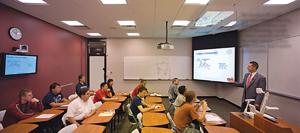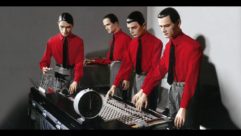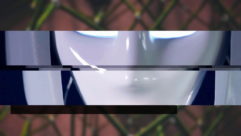

It Doesn’t Take a Genius
The Illinois Institute of Technology, just south of Chicago’s famed downtown Loop, is the kind of place that isn’t likely to tolerate outmoded technology. So when IIT began an upgrade of its classroom AV systems to bolster both its distance-learning and AV capabilities, it knew that the existing equipment would have to go, and that the rooms themselves would need to be reconfigured.
CHALLENGE: Upgrade dated distance-learning classrooms to make them more reliable and easy to use, while expanding the quality and availability of AV throughout campus.THE OVERHAUL BEGINSESTABLISHING CONTROLEach TD sits at a Winsted System 85 console and uses a 12-inch Crestron TPS-12B touch panel to control audio and video switching. Another Crestron product, the CAMI-DJ pan-tilt-zoom (PTZ) controller lets the TD work a joystick to remotely align the camera for the best shot of the person speaking. They monitor video programming on a 15-inch Marshall Electronics V-R151P LCD screen and the various video sources on two Marshall V-R70DP triple-line monitors. Sennheiser HD-201 headphones plugged into a Fostex RM-2 headphone amplifier provide monitoring of broadcast audio.PROJECTING TO THE FUTUREThe wide availability of cutting-edge technology is changing the educational experience at IIT, says Hewitt, who has a master’s degree in multimedia. “The faculty are not used to using video in the classroom, but once it’s there, their expectations change,” she says.
The standard AV in the upgraded distance-learning classrooms at Illinois Institute of Technology include a Sanyo projector, an Elmo document camera, a Sony video camera, and Crestron control systems.
Credit: Talaske/Sound Thinking
SOLUTION: Standardize each room’s configuration, implement simple touch screens, and feed all inputs into a capture station for conversion to streaming video.
THE ILLINOIS INSTITUTE OF TECHNOLOGY (IIT), just south of Chicago’s famed downtown Loop, is the kind of place that isn’t likely to tolerate outmoded technology. So when IIT began in 2006 to plan an upgrade of its classroom AV systems to bolster both its distance-learning and AV capabilities, it knew that the existing equipment, much of it 1980s vintage, would have to go, and that the rooms themselves would need to be reconfigured. “It’s a technology university, so we really had to bring the classrooms into the 21st century,” says Louise Hewitt, director of IIT Online Technical Services.
IIT had a handful of AV rooms dating as far back as 1967. “We had some very basic AV, but the only rooms that had it were the distance-learning rooms,” Hewitt says. Nine AV-equipped rooms eventually grew to 24 on four campuses linked by T1 telecommunications lines. Videoconferencing was transmitted out to corporate and public sites in the Chicago area as part of a state initiative to encourage joint projects between corporations and universities.
THE RIGHT ACOUSTICS FOR A TIGHT BUDGET
Talaske conducted extensive acoustical, background noise, and sound isolation analyses to determine the alterations needed to ensure the distance-learning rooms—each essentially a studio—had the optimal, broadcast-quality audio.
“For the 2007 classroom upgrade, we recommended the addition of the proper amount of 2-inch thick, sound-absorbing panels to each distance-learning room to deaden the liveliness of the rooms and reduce the number of detrimental sound reflections picked up by the microphones,” says Ryan O’Halloran, an audio consultant with Talaske and project manager for this job. “For budgetary reasons, IIT decided to opt out of installing the panels.”
But the resulting sound quality caused IIT to reconsider its decision, according to O’Halloran. When the new rooms were finished, the live room microphone that students used to ask questions still picked up significant room reflection and extraneous noise from the elevated trains less than a block away.
So for the 2008–2009 renovations, Talaske decided to conduct a mock-up in one of the 2007 rooms to demonstrate the affect of sound absorption. The company brought in 300 square feet of the 2-inch fiberglass panels, conducted listening tests with various talker, microphone, and noise scenarios, and recorded the broadcast audio. It tested with all 300 square feet of panels in place, with half, and with none, and produced a DVD that walked IIT staff through each scenario and played the resulting audio.
O’Halloran says the DVD helped IIT determine which setup sufficiently improved the intelligibility of the broadcast audio. The school ultimately compromised and ordered half the sound absorption for the 2008–2009 rooms. IIT and might add panels to the 2007 rooms, says O’Halloran.
“Although additional sound isolation on the façades to reduce train noise was budgetarily and aesthetically off the table,” he says, “the sound absorption did knock down the reverberant ‘amplification’ of the train noise.”
For the upgrade, IIT turned to Talaske, an audio, video, and acoustics consulting firm in nearby Oak Park, Ill., to oversee the ambitious, multiyear project. The school also hired Roscor Corp., an AV-broadcast integration specialist, and Interactive Design Eight Architects (IDEA), a local firm.
“Our job really was to put this to bid so they could get competitive pricing for the AV install and to provide the early coordination with the architect,” says Ryan O’Halloran, a Talaske audio consultant and project manager for the job. The firms worked closely to fit important non-AV elements, such as lighting, into the physical renovations.
The first 10 rooms were finished under tight deadlines during the 2007 summer break: eight in the campus’ Stuart Building; two in its Engineering 1 building. O’Halloran says that because IIT only put out the AV and general contractor bids in late April 2007, the construction manager, Chicago’s Bulley & Andrews, had to be diligent in enforcing the schedule. “The big thing was getting the Marshall desks ordered early,” he says. The project group decided to fast-track the desks, which were custom-made and had an eight-week lead time.
For standard AV, each room was outfitted with a Sanyo PLC-XT25 projector, Elmo EV-2000AF document camera, and Panasonic AG-VP320 VCR/ DVD player. The distance-learning system comprised a Sony BRC300 video camera, a 37-inch Panasonic TH-37PH9UK LCD panel mounted on the rear wall that serves as a confidence monitor so instructors see what’s being broadcast, and connections to the digitizing and broadcasting devices that would deliver content via TV or Internet.
When it came to audio, the Biamp Nexia TC processes the audio signal for both in-room playback and broadcast, and a Crestron CP2E Ethernet control system talks to it over RS-232 serial cable. Outside participants can call in via phone. Phone and program-source audio is played back over Atlas Strategy II ceiling loudspeakers. The instructor speaks into a Shure ULX-P wireless lavalier microphone while students have a Tandberg AudioScience pressure-zone mic.
Perhaps the biggest change was re-orienting the entire AV and distance-learning systems’ management. In the past, student technical directors (TDs) sat at stations scattered in a handful of glassed, broadcast-style control rooms or in some classrooms. Now they all work in a 10-station, central control room in Stuart, linked to rooms in Stuart and Engineering 1 via Internet Protocol (IP) data network running on fiber-optic cable. The IP lets the centralized staff turn rooms on and off remotely, Hewitt says.
Custom-built desks house the touch panels and other classroom-based AV gear.”/>
Custom-built desks house the touch panels and other classroom-based AV gear.
Credit: Talaske/Sound Thinking
The classroom “nervous system” is the Crestron CP2E, “our middle-of-the-road processor,” says Mi-chael Frank, regional manager for consultant market development at Crestron. The CP2E’s purpose is to bring under the control of one interface all the equipment that otherwise might be handled with a confusing array of handheld remotes. “The only way to make it simple is to make all these remotes go away and put one master remote in front of everybody,” Frank says.
For instructors, their master remote is a Crestron 3.6-inch TPS-4LB touch panel with a few large buttons that let them turn the system on and off, select between video sources, and control the audio volume of the various audio and video inputs.
By all accounts the touch controllers have improved the system’s ease of use and reliability. “The best thing is that we’re spending less time training our student technical directors on technical aspects of the stations, and are able to spend more time training them to create good production value,” says John Ka-zibut, chief engineer of IIT Online Technical Services.
Equipment List
Talaske spec’d a wide variety of AV and networking equipment for several different IIT classrooms.
Atlas Strategy II ceiling loudspeakers
Biamp Next TC digital signal processors
Chief RPA176 inverted projector mounts
Crestron CAMI-DJ PTZ controllers
Da-Lite Advantage Electrol 57- x 77-inch motorized projection screens
Elmo EV-2000AF document cameras
Extron MDA 4VEQ 1×5 video distribution amplifiers
Fostex RM-2 headphone amplifiers
Marshall Electronics V-R151P 15-inch LCDs
Panasonic TH-37PH9UK LCD panels
Sanyo PLC-XT25 projectors
SurgeX SX1115RT power strip/conditioners
Shure ULX-P wireless lavalier microphones
Sony BRC300 video cameras
TV One the IT-TBC-GL frame synchronizers
Tandberg AudioScience pressure-zone mics
Winsted System 85 consoles
Source: Talaske
The new equipment does double duty, supporting both AV instruction for students in the classroom and capturing content for the distance-learning program. Computer technology is critical here. O’Halloran says Accordent Capture Station personal computers can take high-resolution input from each classroom device and convert it to a windowed screen format viewable as streaming video over the Web. White-boards, for example, appear as PDF slides.
“It’s an easily edited version of the class, basically saving the class as it goes along,” he says. Online staff serve as the post-production crew, working with the Accordent software to edit out extraneous sounds and visuals, add a title sheet and credits, and within minutes upload the file to the Web so students can view it on their own schedule.
Sometimes the two disciplines—AV and broadcast—cross-pollinate in interesting ways. For example, Hewitt says instructors especially like a new projection feature that lets them annotate textbooks without having to deface the actual pages. O’Halloran says the trick was to place the projector screen in a corner of the room and use Display Devices MRCM rotation mounts that allow the projector to rotate by 90 degrees so it can project onto the whiteboard rather than the regular screen.
O’Halloran says four more distance-learning rooms and 10 or 12 AV rooms are planned for this summer. Another round of room upgrades follows in summer 2009.
Professors and students can annotate PowerPoint slides on the white-board thanks to a mount that allows a projector to rotate between the screen and whiteboards.
Credit: Talaske/Sound Thinking
Professors who had spent decades scratching out complex formulas on chalkboards had to be sold on the benefits of whiteboards. “It’s very hard to switch from blackboards that can span four across a room,” Hewitt says. Many, though, are realizing the convenience of carrying their notebook computers into classrooms and transferring their content to the AV system over the campus-wide wireless network.
But the students are the ultimate beneficiaries. Hewitt points out that the new technology is well suited for teaching engineering, an inherently graphical discipline. “To be able to view it again and again on their schedules really changes the dynamic of the education they’re getting,” she says. It also aids peer interaction and student presentations, and increases the overall dialog.
David Essex is a freelance technology writer based in Antrim, N.H.









